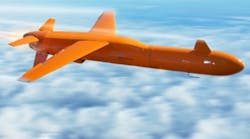Leonardo introduced an aerial target drone at the 2017 Paris Air Show designed to appear as many different threats, intended as a training aid for troops learning how to defend against those threats. The Mirach 40 (M-40) unmanned aerial vehicle (UAV) is based on the company’s Mirach 100/5 target drone, which has become a standard aerial threat simulator for many international armed forces, including France, Italy, and the United Kingdom.
Compared to the Mirach 100/5, the M-40 employs commercial components where available for cost savings. It uses the same ground control station as the Mirach 100/5, so that operators familiar with the Mirach 100/5 will already know how to pilot the M-40, or mixed fleets of M-40 and Mirach 100/5 drones.
The M-40 remotely piloted aerial system (RPAS) is capable of simulating a range of airborne threat targets, such as aircraft and missiles, and the electronic systems employed with those weapons, including radar, infrared (IR), and visual threats. Training sessions can be performed in realistic scenarios, allowing troops to qualify a wide variety of weapons systems and use and reuse the M-40 RPAS.
Since the M-40 was developed by Leonardo using commercial components, it is readily exportable around the world. It is capable of high-G maneuvers as well as low-altitude flights over sea to mimic threats faced by aviation and naval forces. The company will continue to offer the Mirach 100/5 drone as well as the new M-40 drone.

